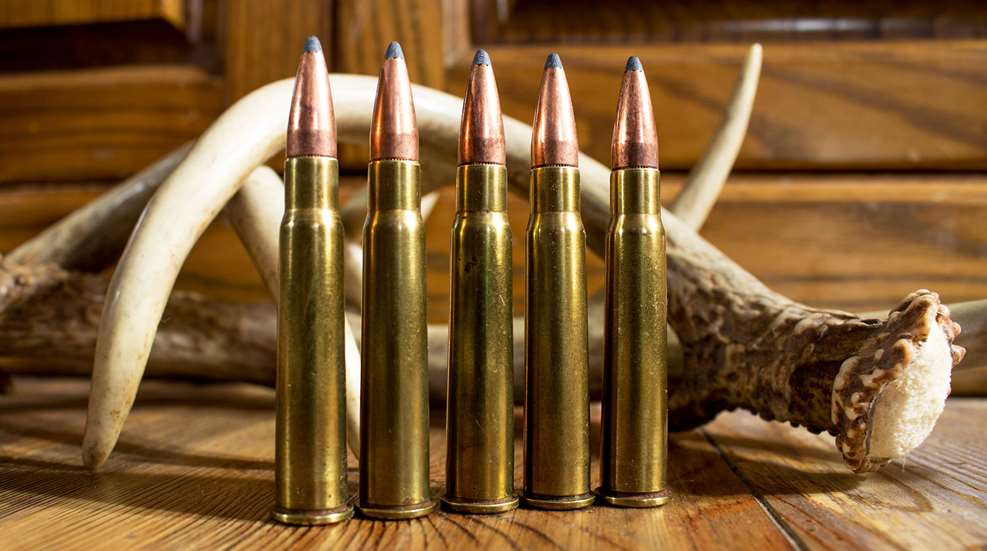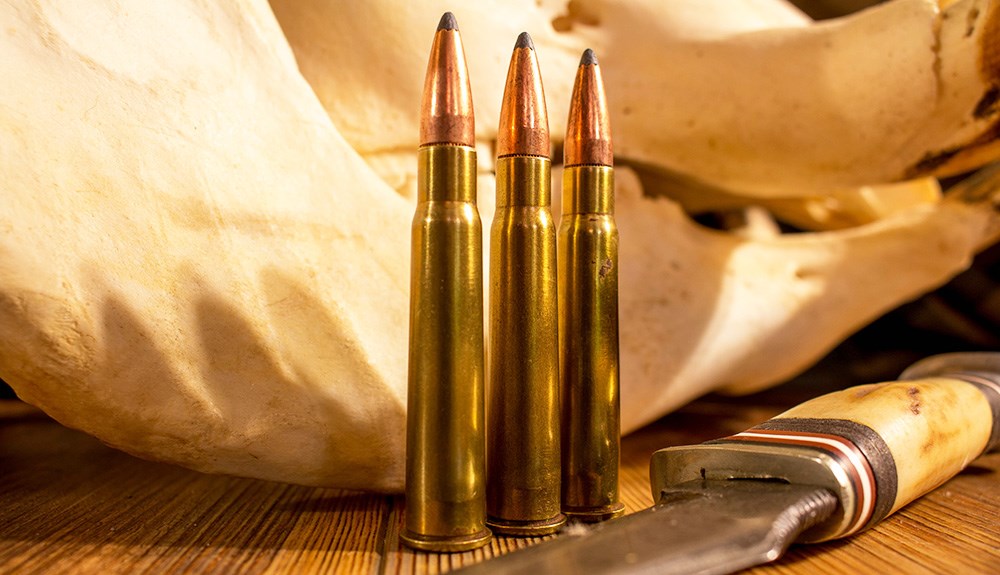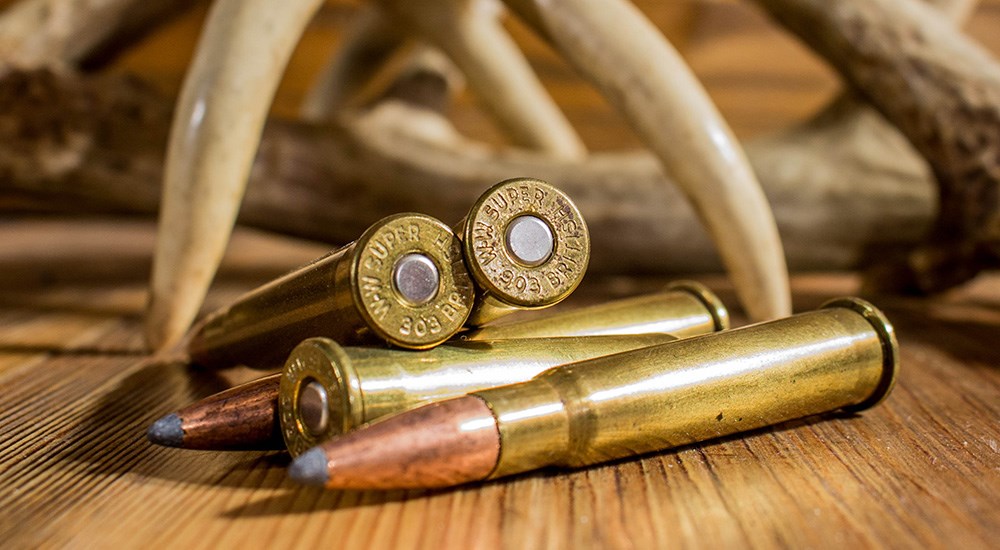
We moved into a new neighborhood when I was 14 years old, and I immediately made friends with a couple of the neighbor boys; we go exploring, hunting, shooting and all the stuff kids do. Back in that different era, we were trusted never to touch a firearm without permission, and adhered to that law. Their dad had his guns in the horizontal wall rack of the day; there was a run-of-the-mill pump shotgun, but his deer rifle was unique. Or, I at least had never seen one like it. It had a lovely reddish-brown finish, and a very unique pistol grip. Being overly-inquisitive, I asked what that rifle was—as was told it was a .303 British.

I’d never heard those words paired, and it seemed as though I’d laid eyes on something very unique. Telling my Dad what I’d seen, he explained that the cartridge was the British military service round, and was very similar in performance to the .308 Winchester or .30-06 Springfield, and that the rifle was a sporterized SMLE, or Short Magazine Lee-Enfield.
The .303 British is a cartridge which began life fueled by blackpowder, and successfully made the transition to smokeless powder, serving the United Kingdom through a number of conflicts, including two World Wars. The cartridge saw the light of day in 1888, when the U.K. adopted it in the Lee-Metford rifle and by 1891, was loaded with smokeless powder. Like so many of the later 19th century designs, the .303 British was a rimmed cartridge, but with a 17-degree shoulder. The case measures 2.222 inches, with an overall cartridge length of 3.075 inches. The original loads used a 215-grain round nose bullet of 0-311-inch to 0.312-inch-diameter, at a muzzle velocity of 2060 fps, in an expanding conformation prior to the Hague Convention of 1899.
There were a number of military variants throughout the early 20th century, satisfying the military requirements, but the .303 British would certainly be found in all corners of the British Empire; like our .30-06 Springfield and .308 Winchester, the military cartridge took root in the hunting fields. Considering the size of the British Empire at the beginning of the 20th century, the cartridge did a bit of travelling. If you are a fan of the classic African and Indian hunting stories, the presence of the .303 British is undeniable. Its status as a military cartridge guaranteed its availability, and the ballistic formula proved good enough for the majority of big game species.

Lt. Col. John Henry Patterson used the .303 British in 1898 to take one of the pair of man-eating lions made famous in his book The Man-eaters of Tsavo, later made famous in movie form as The Ghost and the Darkness. Perusing John ‘Pondoro’ Taylor’s African Rifles and Cartridges, the author alludes to the popularity and availability of the .303 British—in fact he admits to ignorantly purchasing one as his first elephant rifle—but settles on the fact that the cartridge is suitable for “keeping your pot filled.” No matter the projectile loaded in the .303, it was never going to be a suitable choice for elephant or buffalo on any continent, as its bullet weight and velocity limit it to plains game and medium-sized species.
The .303 British remains a viable cartridge for the hunter, even after all these years. Much like the .45-70 Government, 7x57mm Mauser and 8x57mm Mauser, the factory-loaded ammunition is often loaded to lower pressures and velocities in deference to the weaker metallurgy of the earliest rifles; assuredly a higher performance level can be obtained in a rifle of modern construction. In spite of the fact that the bore diameter can handle projectiles weighing up to 215 grains and more, the vast majority of factory loads which remain in production for the .303 British are centered around the 150-, 174- and 180-grain projectiles. Hornady’s Custom Rifle line features a 150-grain bullet at a muzzle velocity of 2685 fps, putting the .303 British on par with the .308 Winchester. Federal’s “Blue Box” sees a 180-grain Speer Hot-Cor loaded to 2460 fps, and a 150-grain Power-Shok softpoint loaded to 2690 fps. Remington catalogs a 180-grain round nose Core-Lokt at 2460 fps, which will give the flavor of the late 19th century loads.
Being rimmed, the .303 British makes a great choice for both lever guns and single shot rifles. It was offered in the 1895 Winchester lever action rifle, many Farquharson falling block single shots, as well as our own Ruger No. 1 single shot. More recently, Uberti chambered their Courteney single shot stalking rifle in .303 British, giving the cartridge a breath of fresh air.

Looking at where the .303 British sits in the crowded field of all-around cartridges, it offers a very usable set of ballistics. The 150-grain bullet at 2,690 fps can be zeroed at 200 yards, striking 2.2 inches high at 100 yards, 9.3 inches low at 300 and 27.4 inches low at 400 yards mark, where that bullet will still retain over 1,000 ft.-lbs. of energy. The 180-grain load actually doesn’t shoot as flat, nor carry energy as well, but at the more common hunting distances will offer better penetration. Bottom line: the .303 British is still a sound hunting cartridge on the most common big game species, and if you were to find a rifle chambered for the classic U.K. military round, there isn’t any real reason to shy away from it, except for ammo availability.
The .303 British is much more popular in Canada, South Africa, Australia and other former British Colonies (we decided that being British colonies was extremely un-hip before the advent of metallic cartridges) than it is here in America, yet the fact remains that it makes a fine hunting cartridge. While the factory loads here in the U.S. are fading, there are component options; Speer offers their Hot-Cor bullet, Hornady its InterLock, and Sierra their Pro-Hunter; so the handloader can keep their .303 British fed.
I would say that, at least here in the United States, the .303 British is suffering the same fate as the .30-40 Krag: it is an ex-military cartridge which is fading away fast. There is no shortage of 7x57mm Mauser, .45-70 Government, .308 Winchester or .30-06 Springfield, but the .303 just doesn’t share those levels of popularity, especially conspiring the fact that the U.K. made the transition to the 7.62x51mm NATO nearly 70 years ago. But I also say “long live the .303 British!” as it has a deeply rooted history in the era of exploration and is tied to the adventurers and hunters who headed to the wilds.
Looking for previous installments of our "Behind the Bullet" series? We've got you covered.
• 26 Nosler
• 6mm Remington
• .270 Winchester Short Magnum
• 360 Buckhammer
• 30 Nosler
• 7-30 Waters
• .370 Sako Magnum
• .17 HMR
• 6.5 Weatherby RPM
• .327 Federal Magnum
• .450 Bushmaster
• 7mm PRC
• .275 Rigby
• .340 Weatherby Magnum
• .416 Ruger
• 27 Nosler
• .257 Roberts
• 7mm Weatherby Magnum
• .300 PRC
• .350 Rigby Magnum
• .450 Nitro Express
• .17 Hornet
• 7mm STW
• 6.8 Western
• .375 Ruger
• .223 Remington
• 6.5x55 Swedish
• .416 Remington Magnum
• .300 Winchester Short Magnum
• 28 Nosler
• 6.5 PRC
• .22 WMR
• .458 Winchester Magnum
• .22 Hornet
• .280 Ackley Improved
• .240 Weatherby Magnum
• .458 Lott
• .264 Winchester Magnum
• .348 Winchester
• 33 Nosler
• .260 Remington
• .30-30 Winchester
• .416 Rigby
• .358 Norma Magnum
• .22 LR
• 7mm-08 Remington
• 8mm Remington Magnum
• .338 Federal
• .224 Valkyrie
• .338-06 A-Square
• 9.3x62mm Mauser
• .257 Weatherby Magnum
• .45-70 Government
• .300 H&H Magnum
• .25-06 Remington
• .30-06 Springfield
• 6.5 Creedmoor
• .300 Remington Ultra Magnum
• 7mm Remington Magnum
• .470 Nitro Express
• .280 Remington
• .300 Winchester Magnum
• .270 Winchester
• .222 Remington
• .45 ACP
• .404 Jeffery
• .44 Remington Magnum
• .41 Remington Magnum
• .243 Winchester
• .338 Winchester Magnum
• .357 S&W Magnum
• 6.5-284 Norma
• 8x57 Mauser
• .38 Smith & Wesson Special
• 7x57mm Mauser
• 9mm Luger
• .35 Whelen
• .454 Casull
• .375 H&H Magnum
• .45 Colt
• .22-250 Remington
• 10mm Auto
• .308 Winchester



































